Power steering fluid is the life blood of your steering system and I’ve found that many folks go years and years without ever changing it. For me, it is yet one more fluid that gets changed on a regular interval, just like my tranny lube, differentials, transfer case, etc. If it is not on your regular list of fluid changes, I strongly urge you to start changing it on a periodic basis. The more you play on the trails with those big tires in the ruts (and on the rocks), the more demand you are putting on your power steering pump and fluid.
With that all said, I had been wanting to add a cooler to the power steering system for some time. When I changed out the power steering pump for a higher flow version which the hydroboost brake system needed, I decided it was a good time to add a cooler. The fluid would be working double duty now, powering both the brake booster and the steering box, so it made sense to provide some temperature relief for the fluid.
NOTE: I will pass along my comments right now in regards to the way I did my PS pump reservoir return line removal. I took the advice of a good friend and the result means you may need to replace an inexpensive hose. Not a biggie to do….just let me explain. In this picture, the hose clamp I am removing is on the pump’s low pressure return line. You may need to remove it when you install your cooler….it depends on where you decide to splice in your cooler, etc. As you can see, I cut the hose before I tried to remove it from the reservoir (no, you don’t have to remove the pump to do this step, I borrowed the picture from my PS pump write-up). The reasoning behind this destructive removal? My buddy was replacing his pump some time ago and he did what anyone would normally do when he got to the return line….remove the hose clamp and then twist the hose a bit to break it loose from the fitting before trying to pull the hose off. When he twisted the hose, the fitting broke off of the reservoir (after all, it is plastic) . DOH! I cut the end of the hose off first and then VERY carefully cut the hose along the length of the fitting and then CAREFULLY peeled it off of the fitting. Purchasing a replacement reservoir by itself does not seem to be an option at this point in time so one is forced to purchase the pump/reservoir as a unit (unless you can get lucky and score just the reservoir by itself). On my ’98, the low pressure return hose is an 11/32″ diameter hose and is NOT molded into the fitting it attaches to on the steering gearbox (it has a hose clamp there as well). While I had a new section of 3/8″ hose (close enough fit) on hand for just this situation, it is also possible that the factory hose had more than an inch of slack in it and cutting off that little bit would not have made any difference (I didn’t bother to check at the time). So there is the explanation and you have the reasons and facts now to make your own decision as to how you want to handle the return hose where it connects to the reservoir. Just remember to be gentle with it. I’ve had the hose off of mine several times….and have not broken anything.
OK….on with the rest of the cooler installation.
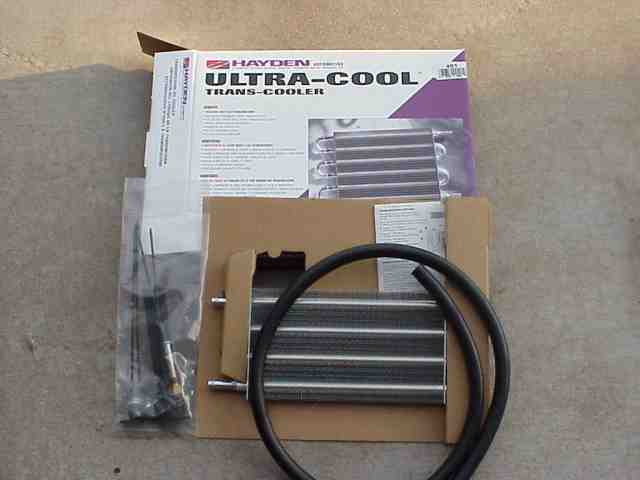
I stopped at the local AutoZone store and checked out their selection of small transmission coolers. I was hoping to not drop a bundle on this part of the project and so a high end cooler was not at the top of my list. They had a small selection of Hayden brand coolers, all tube and fin models. Model #401 was the right size (made for a compact car’s auto tranny) and the price was under $30. I picked one up and kept the receipt, just in case things didn’t work out. It came with a length of low pressure tranny hose, the cooler itself, and some mounting components. Installation is easy….the cooler is installed between the lower pressure outlet port of the steering box and the low pressure inlet on the power steering fluid reservoir.
The longest part of the project was trying to decide where the cooler was going to be mounted. Most would probably put it right behind the grill, in front of the radiator. While this certainly was a possibility, I decided that I had enough of a heat load on the radiator already. I found some unused space directly beneath the winch mounting plate. It was not the most optimum position as it would not provide much (any) air flow during low speed operation. However, it was quite well protected and very much out of the way. It it proved to be that bad, I could always mount a small 12V fan on it and provided forced air cooling, the same as some of the higher end after market tranny coolers.
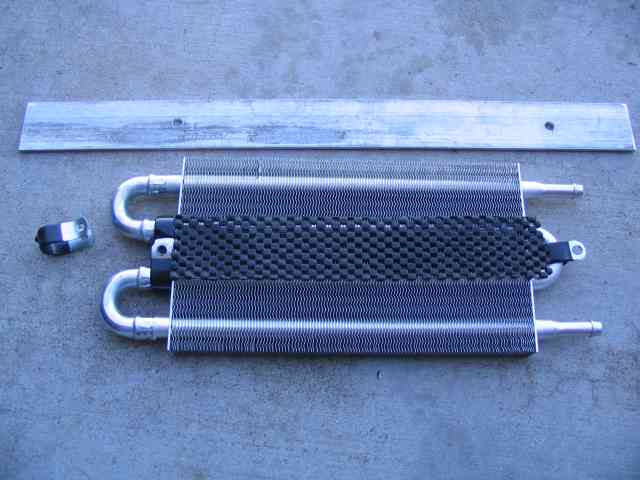
The cooler comes with no mounting tabs what so ever. It does come with plastic push rods that are designed to go through the cooler fins and your radiator’s fins….nope, that wasn’t going to do much for getting this thing mounted under the winch plate. Time to rummage through the junk drawer (you do have a junk drawer or two in the garage, right?). In it, I found some rubber coated metal mounting clips. I’ve used plastic ones just like them for mounting cables and wires in vehicles and under the computer desk. I’m not sure where these metal ones came from but they were in the junk drawer and they were just the right size to fit over the tubes in the cooler. I grabbed a piece of aluminum strap from behind the work bench and cut it to a length that would give me several inches past each end of the cooler. This would become my mounting bracket. Last, I grabbed some rubber drawler liner material and I cut a piece of this the same width as the metal mounting strip. This would provide a bit of cushioning between the cooler and the mounting bracket, much the same as the little rubber pads that come with the cooler were meant to go between it and the radiator fins.
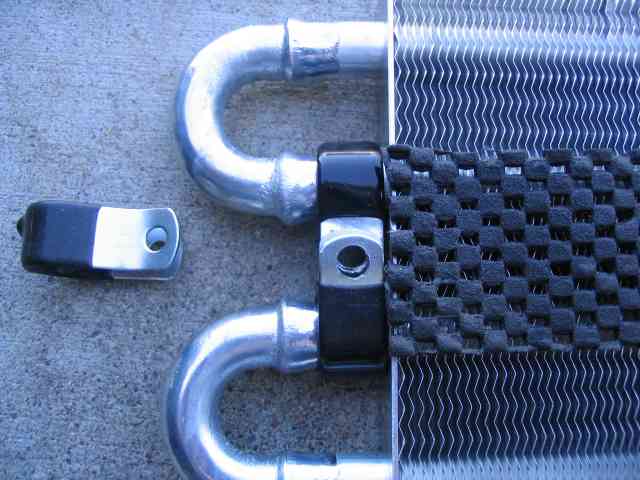
Here is a better view of the mounting clips. I put two of them, facing each other, on one end of the cooler and positioned a single one on the other end. The holes were just a little small for the 1/4″ mounting screws I wanted to use so a quick session with the cordless drill took care of that.
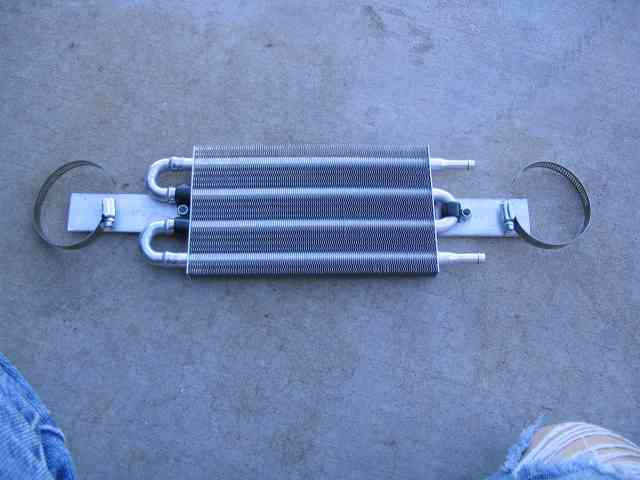
Using some 1/4″ bolts and a couple of Nyloc nuts (didn’t want any vibes to loosen the mounting screws), the cooler was attached to the bracket. A couple of extra large hose clamps (yeah, I had to make a special trip to the NAPA store as the closer AutoZone didn’t have any that were large enough) would be used to hold the mounting bracket in place.
Power Steering Pump Cooler

The hose clamps were used to secure the mounting bracket to the cross member. The lower pressure hose was attached to the cooler and routed back into the engine compartment. The short section of hose that connects the steering box to my PS fluid in-line filter was removed and the cooler’s hoses were slipped over the fittings and the hose clamps were snugged down.
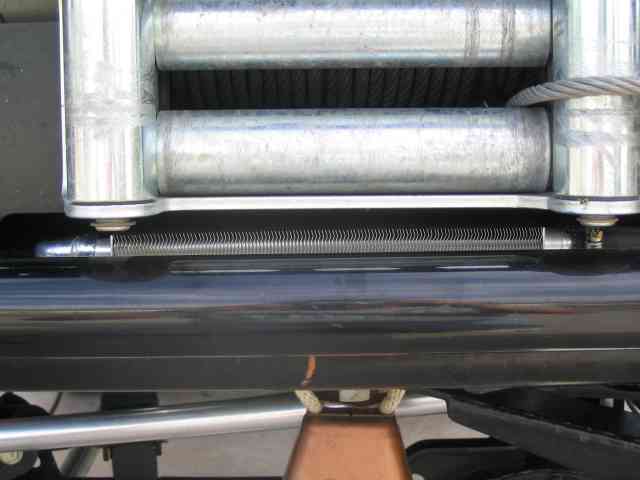
Here is a head on view of the cooler. As I mentioned earlier, there will be very little air flow over the fins at low speed. But the cooler will still dissipate some of the heat and that will be good for the fluid.
After taking a few minutes to bleed the air from the power steering lines, I took the TJ for a test drive after finishing the hose hookups. When I got back, I carefully checked the cooler….yep, it was warming up. I checked the fluid reservoir again and added just a bit more fluid. The project was finished!
There are most likely dozens of ways by which to add a power steering cooler to a TJ. This is but one method that I believe will suit my needs. I wish you good luck if you should decide to add one to your vehicle.
Good trails and remember to TREAD Lightly!
